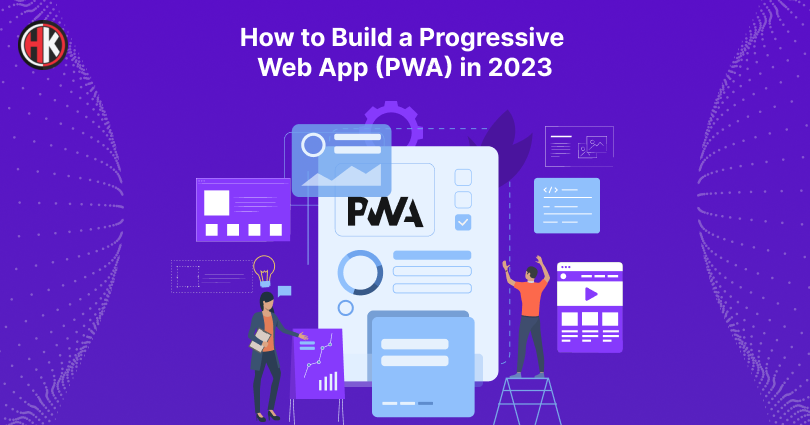
Progressive web apps are the latest technology applications that are used to improve cross-platform efficiency across the web. PWA has grown as a powerful alternative to native mobile applications that offer several advantages to users. The progressive web application supports web pages on the browser as they can give a common mobile application’s UI.
According to recent statistics, PWAs are growing rapidly, and it is expected that by 2025 they will have around 28% of all downloads. These applications are known to increase user engagement as users spend 8x more time than traditional websites.
This shows that if you want to extend your customer base and improve user experience, PWA is an excellent choice to go for. But are these applications beneficial for your company?
If it does, how can you build one to use it to your advantage? So in this article, we will discuss what PWA is and what are the steps to build it.
Table of Contents
What is PWA? How does it work?
A progressive web app is a type of application that is built using popular technologies such as HTML, CSS, and JavaScript. Basically, it’s a web standard that uses design patterns and advanced technologies to provide users with a fast and reliable experience like native mobile apps on desktops.
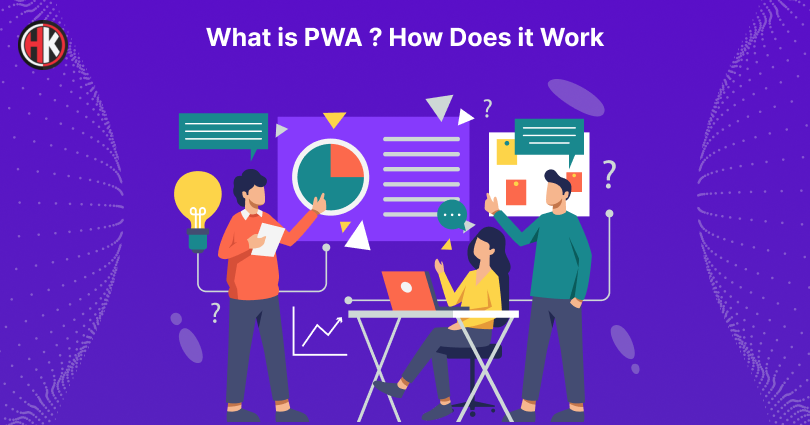
PWAs are useful to test a minimally viable product (MVP) as it allows for rapid and cheaper development. Some examples of PWA include Uber, Starbucks, Pinterest, Forbes, and Twitter.
PWAs have a very less loading time, making them 4x faster with 10 times less data. Moreover, PWAs are capable of working offline and in low-bandwidth environments, resulting in more users and devices enjoying their speed without compromising the quality.
PWAs also offer app-like increased functionality such as offline usage, notifications when new data is available, and some other important factors. This functionality is opened up based on the user’s device, which is working on the same code base and in parallel with your website users in the browser.
You may also read:- How to Create an eCommerce Store Like Amazon
Benefits of Building Progressive Web Application (PWA)
Progressive Web Applications provide an enhanced user experience that increases business efficiency. Now that you know the PWA meaning, let’s look at the key benefits of building PWA for business and their capabilities to find out why businesses, from startups to large business owners, should opt for them.

1. Low development costs
PWAs don’t require different versions for multiple devices; a single progressive app does the job. So, it reduces the efforts of developers, resulting in reducing the cost of PWA development. The cost is 3-4 times lower compared to native mobile applications.
2. App-like style
Nowadays, mobile users prefer apps to browsers as applications are more user-friendly, can operate offline, and have a more interactive user interface and user experience. These applications provide an advanced user experience by combining the look and feel of mobile applications and the best website performance.
Regardless of technologies, the tools, and frameworks that are used to develop PWAs, provide great user experience and have the same speed, responsiveness, and comprehensive capabilities of websites with database access and data automation.
This results in search engines indexing them – one of the main reasons why Google or Bing can find PWA web app pages.
When compared to mobile software which keeps its internal data only for its own use, the pages of these applications are available on the internet, which may have a great impact on the count of page views.
3. Fast Installation
PWAs don’t require a long and complicated installation process, which improves user experience. Users just download an app directly on the websites – they don’t have to install the app from Google Play or App Store. It eases the process and reduces user abandonment. Once downloaded, users can access it via a desktop icon.
Some browsers even offer CTA-like teasers that make users download these applications when they visit particular websites. This functionality is built-in in browsers and allows the apps to enhance their credibility and reliability.
As it does not need installation on devices, users can easily access the PWA app using links, resulting in high shareability.
4. Better Performance
You can go through popular progressive web apps such as Starbucks, Uber, or Flipboard. They cache and serve text, images, and other content in a specific and efficient manner that enables them to operate like websites and improve the running speed.
Along with quick operations, unexceptional performance is another attribute that creates a high impact on user experience and conversion rates.
B2B Retailers and content providers should adopt such software as it enables a more positive user experience than mobile apps by improving customer retention and loyalty.
5. Platform and Device-Independence
PWAs can work anywhere, regardless of the operating systems and the technical capabilities of various devices. A single app satisfies different audience needs and provides an amazing user experience on different endpoints.
At the same time, such an application provides cross-support to users who switch between their devices. Users can get the app that has the same settings and data same as on another device.
This fact also contributes to business automation because companies that rely on PWAs know that the software their employees use performs seamlessly irrespective of the platform or app version.
Also, PWAs are highly responsive to various form factors, as they adapt properly to various sizes of screen.
6. No updating issues
PWAs have specific functionality that they can update automatically without notifying the user and asking for permission requests. These apps update themselves every time when a user makes a visit, thus reducing the need to download batch changes and install them.
They just provide a renewed look with no human involvement.
7. Seamless offline operation
It operates offline, which makes PWAs much more convenient than those websites or apps that require a proper internet connection.
Built-in service workers cache important features and information of top progressive web apps automatically that reduces the necessity to download it and allowing users to access it without internet connectivity.
It is based on the saved information which the user previously accessed. If they try to open those they haven’t visited online, an app can show a custom offline page.
This feature is essential for retailers as it helps them to keep customers engaged with their products – instead of them leaving the online store. This results in increased customer retention.
8. No dependence on app distribution services
App distribution services such as Google Play, App Store, or Microsoft Store set high requirements for software included in their databases. Meeting their requirements becomes quite a time and effort-consuming process.
Also, in some cases, services remove applications from the database without notice if a company doesn’t meet some requirements. So, the super progressive web app will allow developers to avoid complex procedures as they do not require to be stored in similar services.
9. Push Notification Function
PWAs provide device-specific functionality named push notifications. This function can be performed in many ways and allows companies to make the best use of content advertising.
Moreover, these notifications are displayed on desktop screens, one of the many reasons that there is a high chance that they will capture users’ attention, especially when compared to blog entries, email newsletters, or social network posts.
10. Increased Security
PWAs rely on HTTP to provide data safety and reduce the risk of security issues, as this protocol enables to prevent of interference and content modifications. Also, the applications take benefits from Web Bluetooth technology that includes specific security abilities.
Read More:- How to Build a SAAS Application For your Business in 2023
7 Steps to Build an Amazing Progressive Web Application
You have an idea for PWA. So let’s identify how you can create Progressive Web Apps and the steps that go into it.
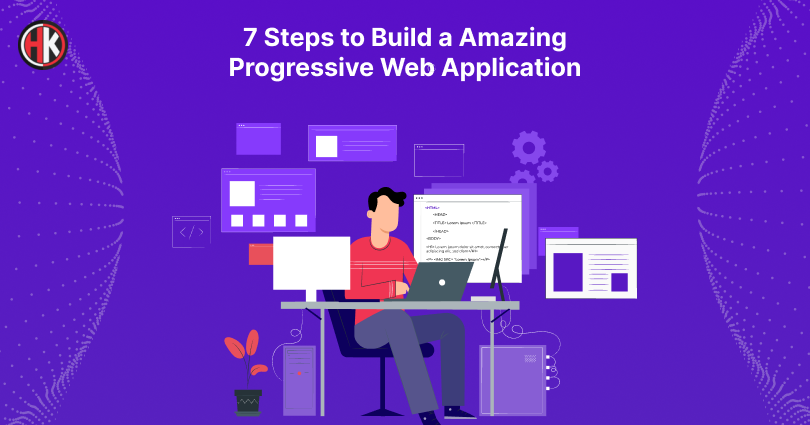
1. Plan your goal and idea
Before building a PWA, plan and ideate the project on how you want your application to be. Get a clear idea of the direction you want, your target audience, business goals, the points you want to achieve the most, etc.
2. Finalize the scope of the project
Once you determine your business goals, outline your plan of action and choose the app development company. Next, work on project specifications, and share the details with the project team members. Then, decide the scope of work and time limitations for the deliverables.
3. Wireframing and Prototyping
An outline of how the app looks on the front end is Wireframing. It includes all details of the progressive application features, functions, and their placements.
You can then convert your wireframes to create a visual representation or model of the final product. This will give you a clear idea of how the app will behave in real time.
4. Developing the app
Select the technology stack and build a Minimum Viable Product (MVP). Planning for MVP is easy as it allows you to validate your idea and learn how the target audience will respond. Once you address the user feedback and all business objectives, you can add some more features to the application.
You can also go for version control of the app, that’s saving the files of the site from time to time, which allows you to revert to an earlier version in case the changes aren’t satisfying.
Moreover, it helps in collaboration to build and test the changes that can be combined and tested in the final product later.
5. Testing
Once you launch your MVP, you can receive feedback from users on your app and improve it. To track the analytics and watch the traffic, and lead generation count to get a rough idea of what’s working and what’s not. Real-time feedback is essential as it will help you to identify bugs, revise the features, and retain end-users.
6. Product Roadmap
A product roadmap is what your progressive web app development lists all the functions and requirements and existing high-level features you may require. Create a product journey during PWA development and keep it active after the launch to track the progress and work on what’s needed.
Progressive Web App Development Cost
The Progressive Web App cost varies depending on the complexity, which tech stacks you are using, the features required, and other project requirements. Factors such as the design, functionality, and integration with other systems finalize the overall app development costs.
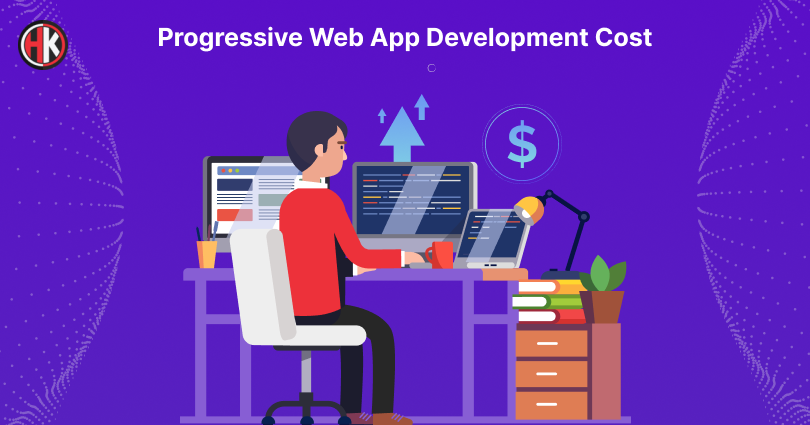
However, in general, the cost of developing a PWA is lower than developing a native mobile app as PWAs doesn’t require multiple codebase or complex integration with different operating systems.
It’s important that you work with an experienced dedicated development team to get an accurate estimate based on the specific requirements of the project.
Before building a PWA, plan and ideate the project on how you want your application to be. Get a clear idea of the direction you want, your target audience, business goals, the points you want to achieve the most, etc.
Major Key Elements of Progressive Web Application (PWA)
Here are some of the key elements of popular progressive web apps:
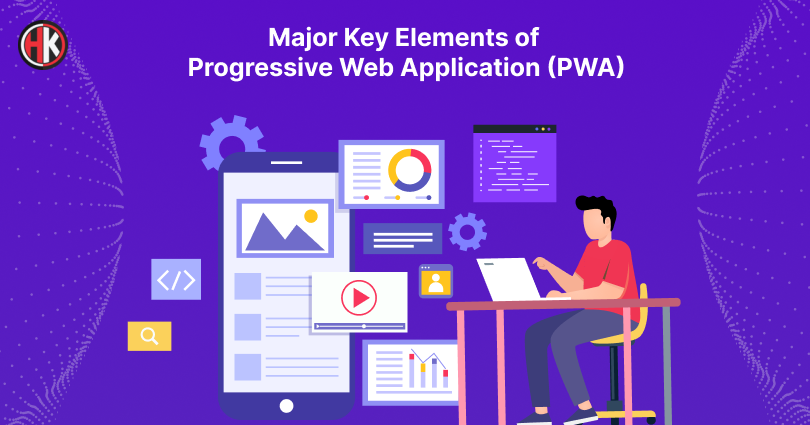
1. Service Workers
Service workers are the heart of progressive web apps and work as a representative layer between the front and back end. It processes all the data requests that go above and beyond and has access to Cache Storage.
From a programming perspective, Service Worker is a JavaScript file that’s connected to the web page’s HTML code, which defines the operational logic of the front end.
2. HTTP
All PWAs use HTTPs, where a secure connection is specified between the end user and the app via encryption. Hosting providers give you SSL certificates, providing an encryption layer around the data sent between the browser and server. This ensures the user that their data is safe and they can trust your app.
3. Push Notifications
PWA’s most valuable feature is Push Notifications that increase audience engagement on the application by 4 times. They instantly show up on the user’s device that captures their attention and making them return to know more or make a purchase.
That’s one compelling way to increase engagement and user retention rates.
4. Web App Manifest
A JSON file, Web App Manifest, is the component that provides PWA with a native-like appearance. With this, the developer can determine how the app is launched and how it looks to the user. It contains the URL, app’s name, icon sizes, links, and location.
To enable the settings, the producer may add a single connection to the manifest file in all the page headers.
5. Application Shell Architecture
The app shell contains the core design elements which can display the app without internet connectivity. They distribute the app’s static, and dynamic content, and a reliable, stable navigation system on any page without modifying the webpage content.
6. Transport Layer Security (TLS)
TLS is a protocol for secure standard exchange between two websites or applications. A website must contain HTTPS and an SSL certificate from the hosting provider.
Read our latest blog article:- PHP vs Node Js: Which Backend is Better For Your Business?
Build a High-Quality Progressive Web App from Us
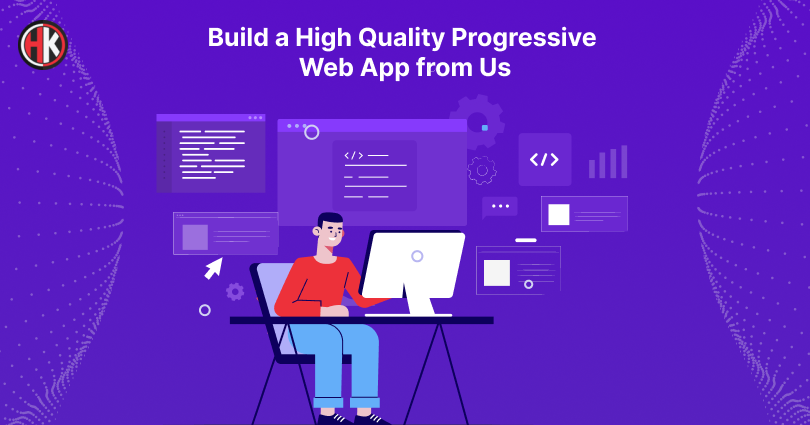
Now that you know the advantage of building a PWA, try exploring the web app development services that HackerKernel has to offer. We have a team of developers who build progressive web apps (PWA), native mobile applications, and cross-platform tools that go well in your digital transformation strategy.
Our development process combines analytical metrics from deep research, strategic thinking, built-in product design, and cutting-edge engineering to build the best PWA apps that deliver top-notch results which drive higher ROI.
Conclusion
Clearly, creating a very simple, basic progressive mobile application is not that hard but only requires an experienced web app developer or a professional development team to help you build, test, and deploy the application.
With an experienced development partner like HackerKernel, you can take the confusion out of the equation and ensure that your users are provided with a top-quality app that ticks all the right boxes.
Contact us today for a quote or to discuss, we can help you build a top-notch application that not only drives better user experience but also results in increased ROI.
FAQ (Frequently Asked Questions)
1. Are Progressive Web Apps Dead?
No, progressive web apps are not dead. They are still a growing trend in web development, offering several advantages to businesses over traditional web applications and native mobile apps.
2. Is PWA better than Native App?
A progressive web application is better than native apps because of their easier development and maintenance, accessibility, a seamless experience across multiple devices, faster loading time, and offline capabilities.
3. Can PWA replace mobile apps?
Yes, PWA can replace some mobile applications, especially those that don’t need tough functionality and depend on content consumption. While some examples of PWA show it may not replace all mobile apps, they may offer businesses a powerful tool to give users an engaging experience.
4. Is Progressive Web Application Good for E-commerce?
Yes, a progressive web app is good for eCommerce websites. Businesses must shift from normal eCommerce websites to PWAs, as it’s very useful. It enhances the user experience of your website and makes it look more appealing than a simple website.
PWA also enhances the design and makes it user-oriented for every browser, device, or platform.
5. How does PWA help in Business Success?
The PWA apps help in improving business success by offering an accessible and mobile-friendly platform to deliver continent and service to users. This can lead to increased engagement, enhanced user experience, and ultimately drive more revenue for the business.

Husain Saify
Founder & CEO
Hey, I am Husain Saify, the Founder and CEO of Hackerkernel. I like to share some valuable information about Industry. You can also Reach Out to me On Linkedin.hello@hackerkernel.com

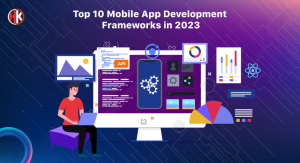

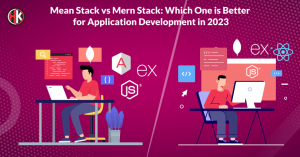
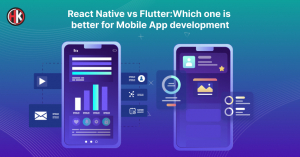
[…] In today’s digital age, every businesses has a strong online presence to engage with the target audience and drive sales. Mobile applications have become an essential element of the online world, and they provide an excellent opportunity to interact with clients.Today web applications can be a time-consuming and costly process. So that various large companies are moved to building progressive web apps […]
Yes
[…] web applications. By utilizing web technologies such as HTML, CSS, and JavaScript, developers can build progressive web apps that offer an enhanced user experience, increased engagement, and improved performance by bringing together the best aspects of both web […]
[…] smartphones have become an essential part of our lives. Whether it is to build Native apps or you create progressive web apps (PWAs) both are common choices when it comes to creating mobile applications. Both have their own […]